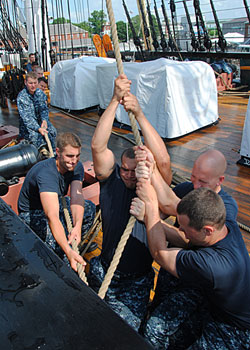There were no hard and fast rules for which shanties went with which jobs but they fell into a few general categories.
Short Haul Shanties
Short hauls (or “drags”) called for short, sharp tugs on a rope. Dragging out the bottom corners of the foresail (the largest sail on the foremast), raising a whaleboat and giving the final haul to the heavy sails and yards are all examples of jobs that were so difficult the men could only pull one time during a chorus. The shanties that went well with this kind of work were usually brief and to the point. There might be a few notes for the shantyman to get things going at the right pace followed by a few notes to help the sailors work up to a good strong tug.
Long Haul or Halyard Shanties
Halyards are the lines of rope that raise the sails and yards. Most of the yards were attached to the upright masts with a loose collar so that the yard itself was raised to stretch out the sail hanging from it: that’s why the rope was called a hal—or haul—yard. Together these could weigh over a thousand pounds so raising and lowering the sails was not as easy as it sounds. Sailors needed both strength and endurance to do these jobs. Just lifting all that weight would be difficult enough but as the sails went up and began to fill with wind, the men had to work even harder to keep the heavy sails under control.

Wikimedia Commons Jacques-Louis David